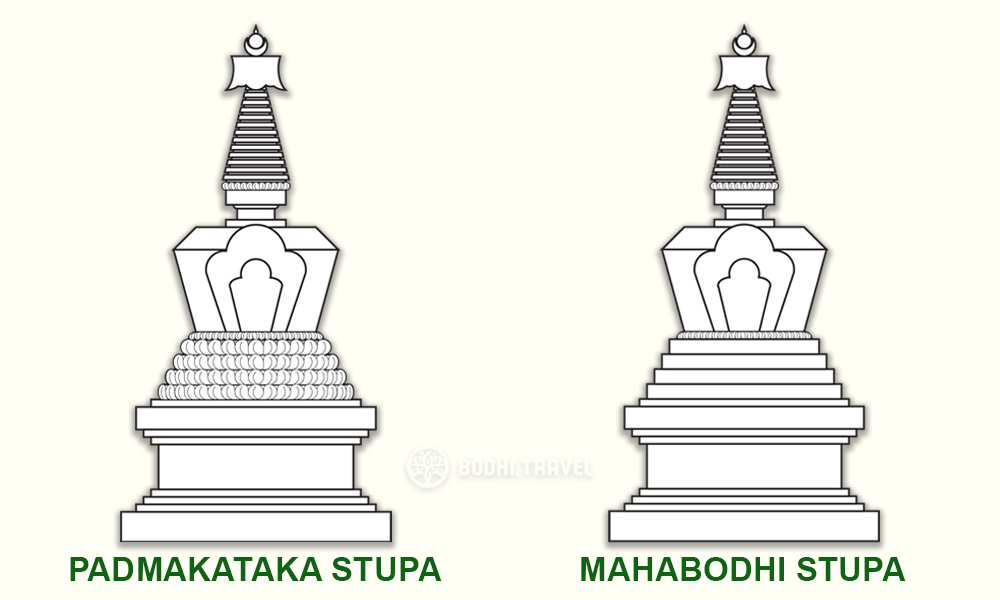
The Stupa II
BODHI ADMIN - Posted on September 13, 2019 - 4,097 Views
In an earlier blog, we discussed the Stupa. In Tibet, the stupa is known as the chorten. The stupa evolved to become very rich in symbolism.
Read our previous blog here: The Stupa
The basic design of the chorten is that of a three-dimensional mandala. The main design of the chorten comprises of square, rectangular, round and vertical shapes. Often, the stupa is topped with victory flags and parasols of enlightenment.
In the Tibetan tradition, there are eight types of stupa with different representations which correspond to major life events of the Buddha.

Padmakataka Stupa
Sometimes known as the Lotus Blossom Stupa, the Padmakataka stupa symbolise the birth and birthplace (Lumbini, Nepal) of the Prince Siddhartha who eventually became the Shakyamuni Buddha. The four base levels of the stupa are decorated with either alcoves or lotus-petals.
Mahabodhi Stupa
The Mahabodhi (Great Awakening) Stupa symbolises the Buddha’s Enlightenment under the Bodhi Tree. Arguably the greatest event in the Buddha’s life, the Buddha’s Enlightenment was attained after a lengthy fight with Mara and his army.

Bauhaudvara Stupa
The Bauhaudvara Stupa is recognisable by the its symbolism of many of many auspicious doors. These doors symbolising the proverbial 840,000 paths to Enlightenment as taught by the Buddha. The Teachings of the Buddha are many and given in accordance to the level of understanding of the recipients.
Pratiharya Stupa
The Pratiharya stupa is a representation of the Great Miracles performed by the Buddha at Shravasti when He engaged in debates and discussions with challenges to His Teachings. Shravastis is the location of the great Jeta Grove where the Buddha gave many sermons.

Devavatara Stupa
According to legends, the Buddha ascended to the Tushita heavens where He gave Teachings to His mother (Queen Maya reburned as a celestial being after death), the god Indra and other celestial beings. After three months in the heaven, He returned to earth (Samkasya) via a ladder.
This incident is marked and celebrated as Lhabab Duchen in the Tibetan traditions. The Devavatara Stupa, with the stairs symbol in the middle, symbolises the event.
Antaryana Stupa
Despite being the Enlightened One, the Buddha was not without His critics and detractors. One of His more prominent opponents was His own cousin Devadatta. Devadatta’s machinations resulted in a schism in which some followers left the Buddha. Their later reconciliation is symbolised by the Antaryana Stupa. This Stupa has four octagonal steps with equal sides.

Vijaya Stupa
The victory (Vijaya) stupa commemorates the Buddha’s recovery from a serious illness. His disciples pleaded with the Buddha to prolong His life and He acceded by a further three months. The steps of this Stupa are round.
Mahaparinirvana Stupa
Symbol of the Buddha’s Parinirvana, this Stupa has no steps and rest directly on the base. During the Buddha’s Parinirvana, He urged all Buddhists to be diligent in their efforts to attain Enlightenment.
_______________
Intrigued? Join our tours and we will show you more!
Singapore Walking Tours: https://www.bodhi.travel/destinations/singapore
Chiang Mai Buddhism and Cultural Tour: https://www.bodhi.travel/packages/thailand
Borobudur Ancient Candis Tour: https://www.bodhi.travel/packages/indonesia
Sikkim - Breathtaking Himalayas Tour: https://www.bodhi.travel/packages/india-sikkim
_______________
Original image source: By The original uploader was Woodega at English Wikipedia. - Transferred from en.wikipedia to Commons by Oxyman using CommonsHelper., CC BY-SA 3.0, https://commons.wikimedia.org/w/index.php?curid=7912599
MORE ARTICLES: The Stupa
MORE ARTICLES: Sitting Postures
MORE ARTICLES: Om Mani Padme Hum




